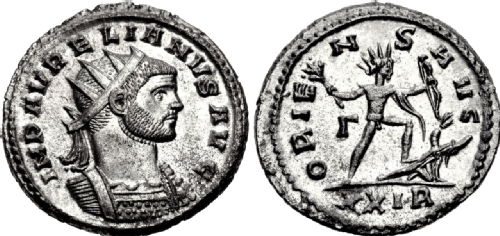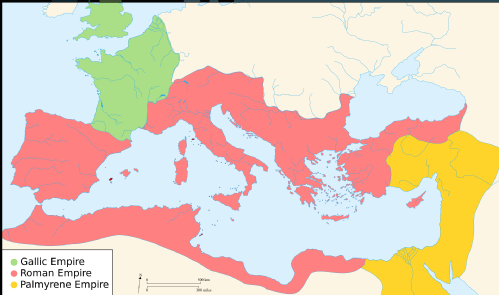All 1 entries tagged Sol Invictus
No other Warwick Blogs use the tag Sol Invictus on entries | View entries tagged Sol Invictus at Technorati | There are no images tagged Sol Invictus on this blog
November 01, 2016
Reunifying the empire: Aurelius and Sol Invictus.
 |
|
|
Antoninianus. RIC V 64
Obverse: IMP AVRELIANVS AVG. Radiate and cuirassed bust of Aurelian facing right.
Reverse: ORIENS AVG. Sol Invictus holding laurel-branch and bow, treading on fallen enemy.
Γ (mintmark) behind Sol, XXIR in exergue.
|
This is an antoninianus (a denomination theoretically worth 2 denarii) of Aurelian, who was emperor of the Roman Empire AD 270-275. It is worthy of study because of the sheer amount of information we can draw, in terms of military, economic and religious history, from this one type of coin.
We see that Aurelian wishes to be seen as a military figure; this is conveyed through his depiction on the obverse in armour and on the reverse the depiction of Sol treading down on an enemy. To properly understand the meaning of this imagery we have to consider the state of the empire as Aurelian comes to power. The empire has fragmented with Queen Zenobia ruling in the east out of Palmyra and Tetricus declared emperor in the West as part of the Gallic Empire (see map below). In AD 272 Queen Zenobia, who was in control of Egypt, cut off the grain supply to Rome. Aurelian responded by taking his army east and defeating her, regaining control over the eastern portion of the empire. In AD 273 he gained the title Restitutor Orientis (Restorer of the East) which he placed on his coinage (RIC V 140). In 274 after returning to Rome, Aurelian marched West, defeating Tetricus at the Battle of Chalons, reunifying the empire and gaining the title Restitutor Orbis (Restorer of the World). This coin type has a date range of AD 270-275. At the beginning of his rule, imagery of victory might have been associated by the average Roman citizen with Aurelian’s victory against the barbarians at Alemanni in northern Italy. In AD 275 this type of imagery might have been interpreted as representative of the victories that had reunified the empire (Zosimus 1.25). In this case the legend on the coin, ORIENS AVG, refers to the east, and suggests that the intended message was Aurelian’s successes in this region.
 |
|
Map of the Roman World in AD 271
|
The economic history this coin reveals is also interesting. The radiate crown on Aurelian’s head is there to indicate that this is an antoninianus rather than a denarius. This denomination was introduced in AD 215 to combat a lack of silver. Its introduction may have helped generate the rampant inflation that led to the silver purity of the antoninianus crashing to just 3.79% by AD 270. This specific coin is an example of what followed: Aurelian reformed the coinage, motivated by a desire to restore some confidence in the currency and to curb inflation. We know this because the legend in the exergue of this coin reads ‘XXI’. This was a guarantee that 20 of these coins could be exchanged for one argenteus of pure silver (20:1, XX:I). The coins were promised to have 5% silver, although if we actually drilled into the coin we would probably only find a purity of 4.1%, due to surface leeching of silver over the years. Another part of Aurelian’s coinage reform was increasing the physical weight of the coinage; before the reform between 86-98 coins were made from each pound of billion (debased silver), following the reform this was lowered to a range of 81-90, giving a theoretical weight to each coin of 4.03g.
The religious history we can gain from this coin is the changed role of Sol in this period. No longer is he merely pictured in his traditional form with the whip or globe standing emollient. Now he appears with a traditional whip but also a bow, treading down the enemy, invoking the new cult of Sol Invictus in action, even if the legend is limited to ORIENS AVG (Rising (Sun) of the emperor). Coins were also produced with the legend SOLI INVICTO (Sol the Unconquerable) (RIC V 154). This represents a change in this period in the Rome pantheon, with the rise of Sol Invictus to a position of prominence. Aurelian’s victories are associated with Sol rather than Jupiter. There is scholarly debate over the exact nature of this cult, with the traditional view being Aurelian imported an eastern deity, but recent scholarship has challenged this, suggesting that the cult may have developed out of the traditional Graeco-Roman god Sol. The additional evidence for Sol Invictus taking greater prominence is Aurelian’s new temple built to Sol Invictus in Rome and the setting up of a new priestly college, pontifices dei solis. A final thought on the influence of Sol Invictus on our world today is his holy day, dies Invictus Natalis. This was placed on the 25th December and while it was an important day anyway within the Roman calendar, being the winter solstice, one is left to wonder whether the particular rise in the importance of that date due to Sol Invictus influenced early Christians in their decision to adopt this date as the birth date of Christ.
 |
This month's coin was written by William Tait, Third year undergraduate in Ancient History and Classical Archaeology with a particular interest in the 3rd century AD and how coinage can improve our understanding of this period.'
Bibliography:
Drinkwater, J.F. (1987), The Gallic Empire: Separatism and continuity in the north-western provinces of the Roman Empire, Franz Steiner Verlag, Stuttgart.
Halsberghe, G. (1972), The cult of Sol Invictus, Leiden: Brill.
Hijmans, S. E. (1996), The Sun which did not rise in the East; the Cult of Sol Invictus in the Light of Non-Literary Evidence. Babesch 71: 115-150.
Southern, P. (2015) The Roman Empire from Severus to Constantine, Routledge, London.
Watson, A. (1999), Aurelian and Third Century, Routledge, London and New York.
Zosimus, New History, trans. T. Chaplin & W. Green (London: Green and Chaplin 1814)
Coin image reproduced courtesy of Classical Numismatic Group Inc., (Auction 88, lot 1399) (www.cngcoins.com)
 Clare Rowan
Clare Rowan

 Please wait - comments are loading
Please wait - comments are loading

 Loading…
Loading…

